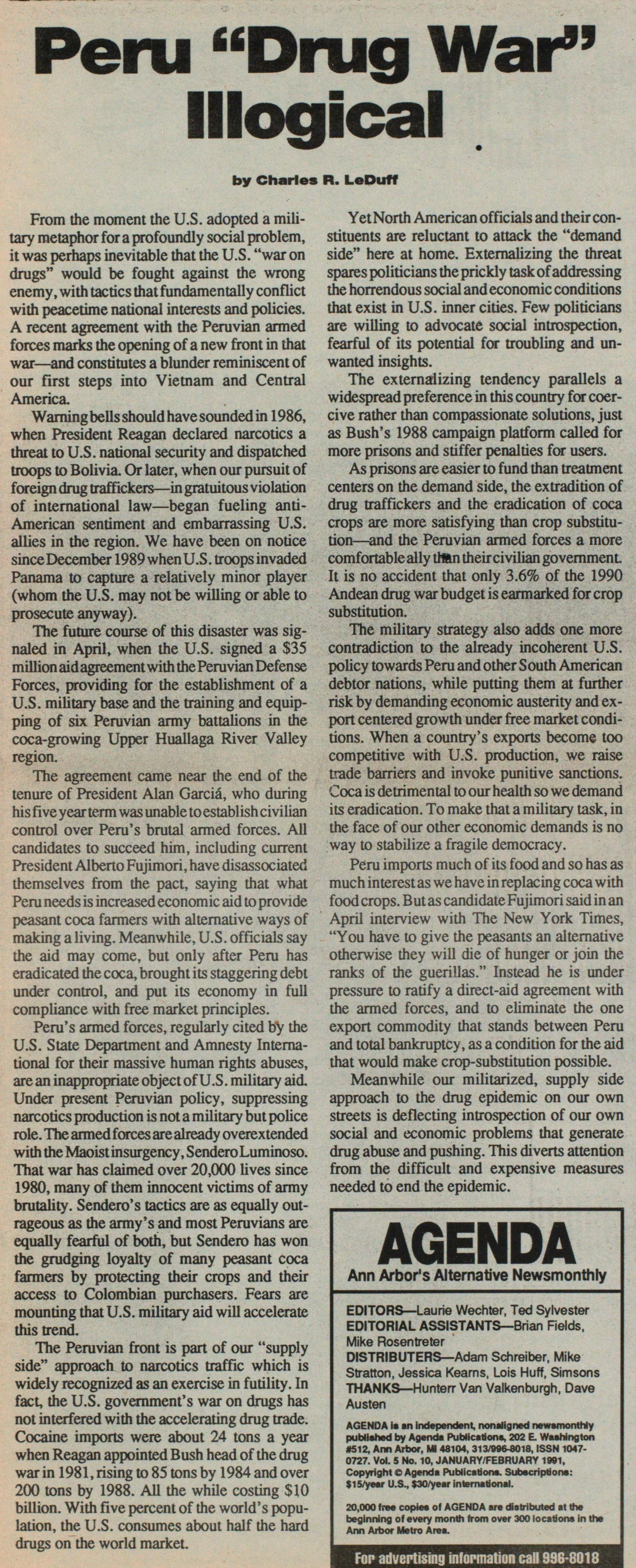Peru "Drug War" Illogical

by Charles R. LeDuff
From the moment the U.S. adopted a military metaphor for a profoundly social problem, it was perhaps inevitable that the U.S. "war on drugs" would be fought against the wrong enemy , with tactics that fundamentally conflict with peacetime national interests and policies. A recent agreement with the Peruvian armed forces marks the opening of a new front in that war - and constitutes a blunder reminiscent of our First steps into Vietnam and Central America.
Warning bells should have sounded in 1986, when President Reagan declared narcotics a threat to U.S. national security and dispatched troops to Bolivia. Or later, when our pursuit of foreign drug traffickers - in gratuitous violation of international law - began fueling anti-American sentiment and embarrassing U.S. allies in the region. We have been on notice since December 1989 when U.S . troops invaded Panama to capture a relatively minor player (whom the U.S. may not be willing or able to prosecute anyway).
The future course of this disaster was signaled in April, when the U.S. signed a $35 million aid agreement with the Peruvian Defense Forces, providing for the establishment of a U.S. military base and the training and equipping of six Peruvian army battalions in the coca-growing Upper Huallaga River Valley region.
The agreement came near the end of the tenure of President Alan Garciá, who during his five year term was unable to establish civilian control over Peru's brutal armed forces. All candidates to succeed him, including current President Alberto Fujimori, have disassociated themselves from the pact, saying that what Peru needs is increased economic aid to provide peasant coca farmers with alternative ways of making a living. Meanwhile, U.S. officials say the aid may come, but only after Peru has eradicated the coca, brought its staggering debt under control, and put its economy in full compliance with free market principles.
Peru's armed forces, regularly cited by the U.S. State Department and Amnesty International for their massive human rights abuses, are an inappropriate object of U.S. military aid. Under present Peruvian policy, suppressing narcotics production is not a military but police role. The armed forces are already overextended with the Maoist insurgency, Sendero Luminoso. That war has claimed over 20,000 lives since 1980, many of them innocent victims of army brutality. Sendero' s tactics are as equally outrageous as the army's and most Peruvians are equally fearful of both, but Sendero has won the grudging loyalty of many peasant coca farmers by protecting their crops and their access to Colombian purchasers. Fears are mounting that U.S. military aid will accelerate this trend.
The Peruvian front is part of our "supply side" approach to narcotics traffic which is widely recognized as an exercise in futility. In fact, the U.S. government's war on drugs has not interfered with the accelerating drug trade. Cocaine imports were about 24 tons a year when Reagan appointed Bush head of the drug war in 1981, rising to 85 tons by 1984 and over 200 tons by 1988. All the while costing $10 billion. With five percent of the world's population, the U.S. consumes about half the hard drugs on the world market.
Yet North American officials and their constituents are reluctant to attack the "demand side" here at home. Externalizing the threat spares politicians the prickly task of addressing the horrendous social and economic conditions that exist in U.S. inner cities. Few politicians are willing to advocate social introspection, fearful of its potential for troubling and unwanted insights.
The externadizing tendeney parallels a widespread preference in this country for coercive rather than compassionate solutions, just as Bush's 1988 campaign platform called for more prisons and stiffer penalties for users.
As prisons are easier to fund than treatment centers on the demand side, the extradition of drug traffickers and the eradication of coca crops are more satisfying than crop substitution - and the Peruvian armed forces a more comfortable ally than their civilian government. It is no accident that only 3.6% of the 1990 Andean drug war budget is earmarked for crop substitution.
The military strategy also adds one more contradiction to the already incoherent U.S. policy towards Peru and other South American debtor nations, while putting them at further risk by demanding economic austerity and export centered growth under free market conditions. When a country's exports become too competitive with U.S. production, we raise trade barriers and invoke punitive sanctions. Coca is detrimental to our health so we demand its eradication. To make that a military task, in the face of our other economic demands is no way to stabilize a fragile democracy.
Peru imports much of its food and so has as much interest as we have in replacing coca with food crops. But as candidate Fujimori said in an April interview with The New York Times, "You have to give the peasants an altemative otherwise they will die of hunger or join the ranks of the guerillas." Instead he is under pressure to ratify a direct-aid agreement with the armed forces, and to elimínate the one export commodity that stands between Peru and total bankruptcy, as a condition for the aid that would make crop-substitution possible.
Meanwhile our militarized, supply side approach to the drug epidemic on our own streets is deflecting introspection of our own social and economic problems that generate drug abuse and pushing. This diverts attention from the diffïcult and expensive measures needed to end the epidemic.